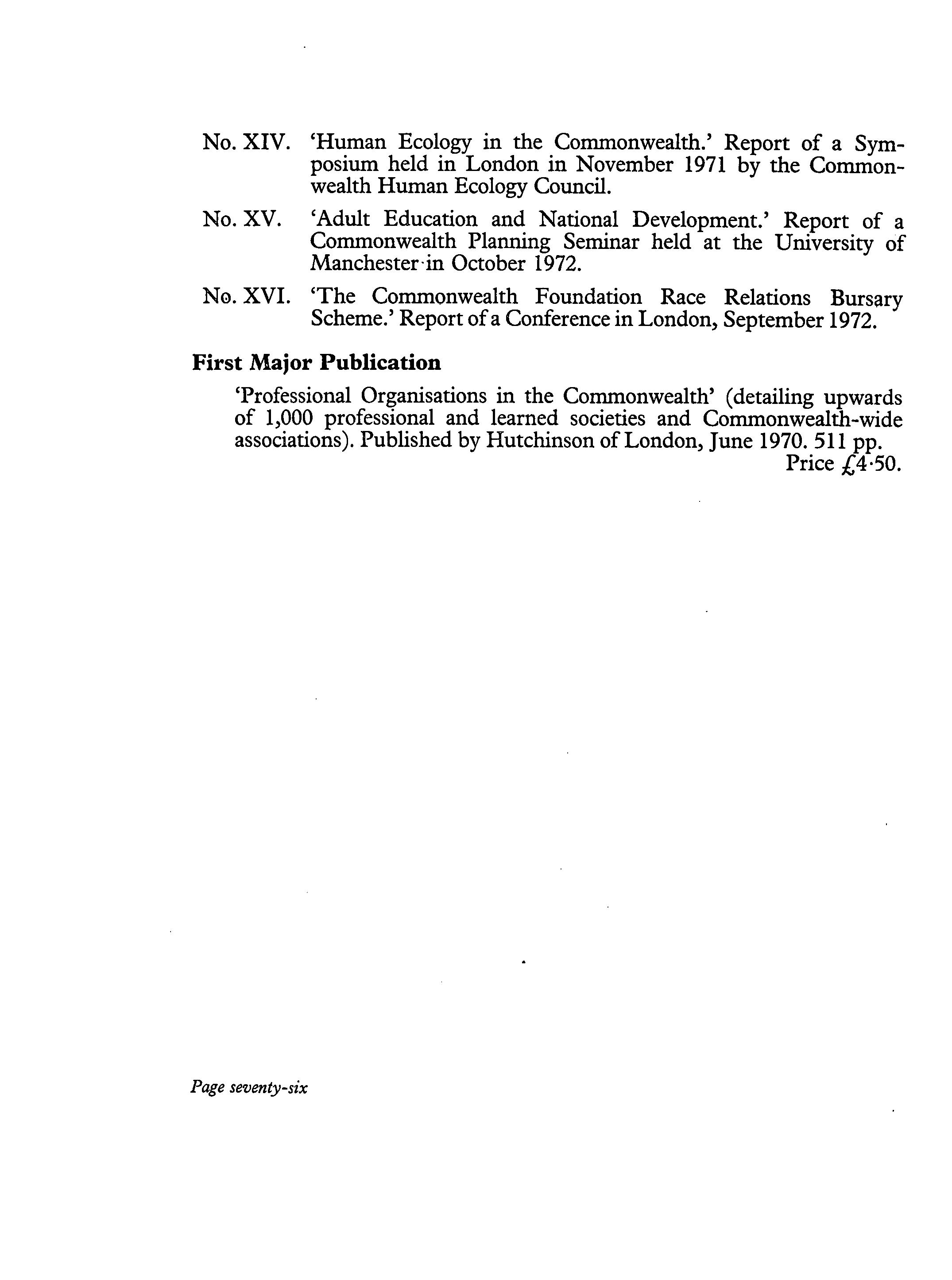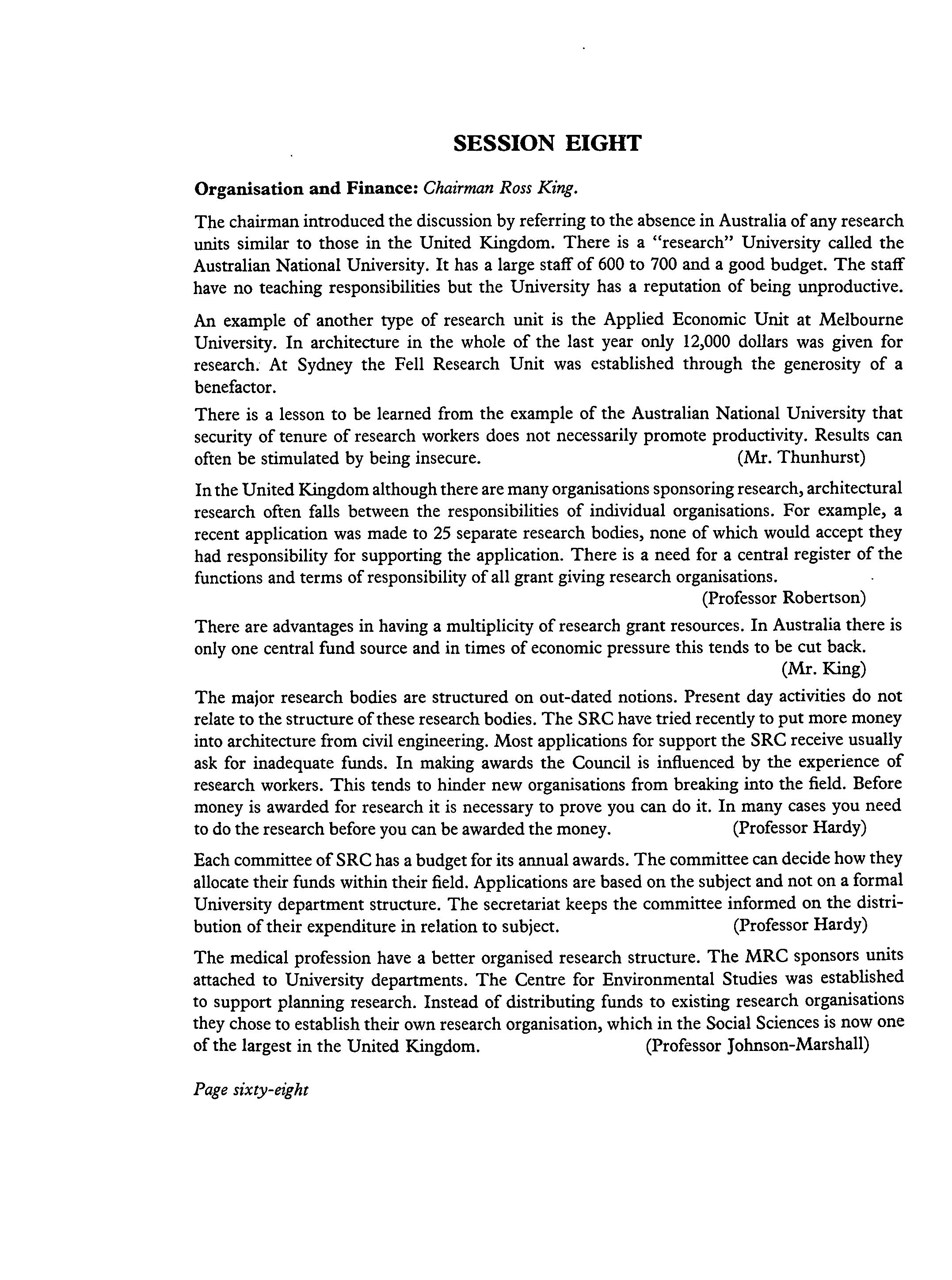
16 minute read
Concluding Session: Summary and Conclusions
SESSION EIGHT
Organisation and Finance: Chairman Ross King. The chairman introduced the discussion by referring to the absence in Australia of any research units similar to those in the United Kingdom. There is a "research" University called the Australian National University. It has a large staff of 600 to 700 and a good budget. The staff have no teaching responsibilities but the University has a reputation of being unproductive. An example of another type of research unit is the Applied Economic Unit at Melbourne University. In architecture in the whole of the last year only 12,000 dollars was given for research. At Sydney the Fell Research Unit was established through the generosity of a benefactor. There is a lesson to be learned from the example of the Australian National University that security of tenure of research workers does not necessarily promote productivity. Results can often be stimulated by being insecure. (Mr. Thunhurst) In the United Kingdom although there are many organisations sponsoring research, architectural research often falls between the responsibilities of individual organisations. For example, a recent application was made to 25 separate research bodies, none of which would accept they had responsibility for supporting the application. There is a need for a central register of the functions and terms of responsibility of all grant giving research organisations. (Professor Robertson) There are advantages in having a multiplicity of research grant resources. In Australia there is only one central fund source and in times of economic pressure this tends to be cut back. (Mr. King) The major research bodies are structured on out-dated notions. Present day activities do not relate to the structure of these research bodies. The SRC have tried recently to put more money into architecture from civil engineering. Most applications for support the SRC receive usually ask for inadequate funds. In making awards the Council is influenced by the experience of research workers. This tends to hinder new organisations from breaking into the field. Before money is awarded for research it is necessary to prove you can do it. In many cases you need to do the research before you can be awarded the money. (Professor Hardy) Each committee of SRC has a budget for its annual awards. The committee can decide how they allocate their funds within their field. Applications are based on the subject and not on a formal University department structure. The secretariat keeps the committee informed on the distri- bution of their expenditure in relation to subject. (Professor Hardy) The medical profession have a better organised research structure. The MRC sponsors units attached to University departments. The Centre for Environmental Studies was established to support planning research. Instead of distributing funds to existing research organisations they chose to establish their own research organisation, which in the Social Sciences is now one of the largest in the United Kingdom. (Professor Johnson-Marshall)
Advertisement
Page sixty-eight
In recent years the United Kingdom aid programme has reflected an increasing awareness that research is one of the most valuable contributions which can be offered to the developing countries. Too often opportunities are missed because those in the receiving country, not being expert, are unable to identify problems far less see ways in which they might be tackled. Because of this, it seems necessary that the two countries, developed and developing, should establish a continuing working relationship at a technical level with the express purpose of specifying the aid programme. Once a developed country decides to run an aid programme it assumes that it has received some benefit from so doing. Whatever it is, Kudos, conscience or commerce, it is established by the very act of giving. But for the developing country—the other partner in the deal—these may all be disadvantages. His only propsect of benefit is in the success of the projects to be undertaken. In the long run this is also the only real benefit to the donor. To achieve success it is necessary for a tough bargain to be struck and for all parties to the agreement, the politicians, the civil servant, the technical officers, etc., to have a strong interest in the success of the project. This argument lies behind India's insistence that she will accept technical aid only when she can provide suitable staff to work alongside the expatriates and take over from them. (Mr. Rodger) There is a need for factual information on the comparative expenditures of Commonwealth countries on architectural research. A document could be produced analysing the percentage of funds going to architectural research in the Universities represented at the Seminar. This in turn needs comparing to funds going to other disciplines. (Professor Matthew) (Professor Howarth) (Professor Wilson) Apart from the statistics of the situation, the classification of architectural research work being developed needs recording. The Department of the Environment in Canada is establishing such a classification. (Dean Desbarats) Poor staff student ratios in Schools of Architecture and the large number of staff student contact hours required in architectural education make it difficult for teachers to devote time to research. This tends to encourage the establishment of full time research units. (Professor Wilson) A nucleus of permanent research staff are essential to develop meaningful research programmes in Universities. The University of Montreal funds a research director and secretarial staff in our Faculty. (Mr. King) (Dean Desbarats) Other departments in Universities still adhere to the traditional pattern of teaching staff undertaking research and do not have full time research units. Many teaching staff even under the pressures of inadequate staff/student ratios can still be involved in research by supervising programmes of postgraduate study. (Professor Wilson) (Professor Hardy)
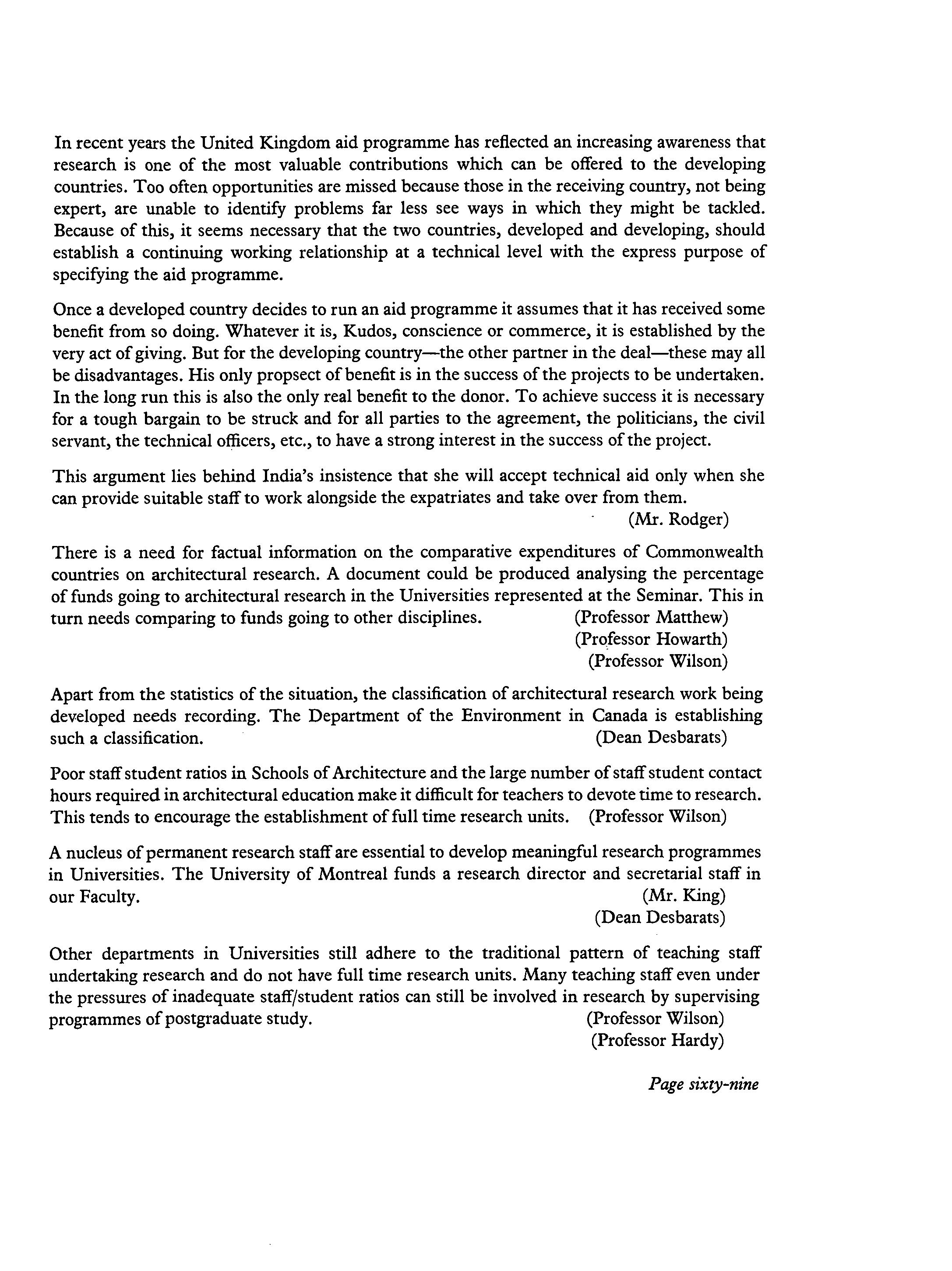
Page sixty-nine
Different kinds of research need to be tackled in different ways. Some research can be tackled at weekends and evenings. Architectural and planning research needs tackling by large full time research groups involving different disciplines where appropriate. (Professor Johnson-Marhsall)
CONCLUDING SESSION
Summary and Conclusions: Chairman, Professor Sir Robert H. Matthew.
The Chairman introduced Dean T. Howarth who had been asked to summarise the proceedings. Dean Howarth's comments were as follows:- Despite a widely ranging discussion and a valuable exchange of views, no clear definition of architectural research had been forthcoming during the symposium. However, five areas of common interest had emerged which required action. They were:—
I. Research funds—sources and availability Professional relationships The research worker Subject areas for research Communication of results
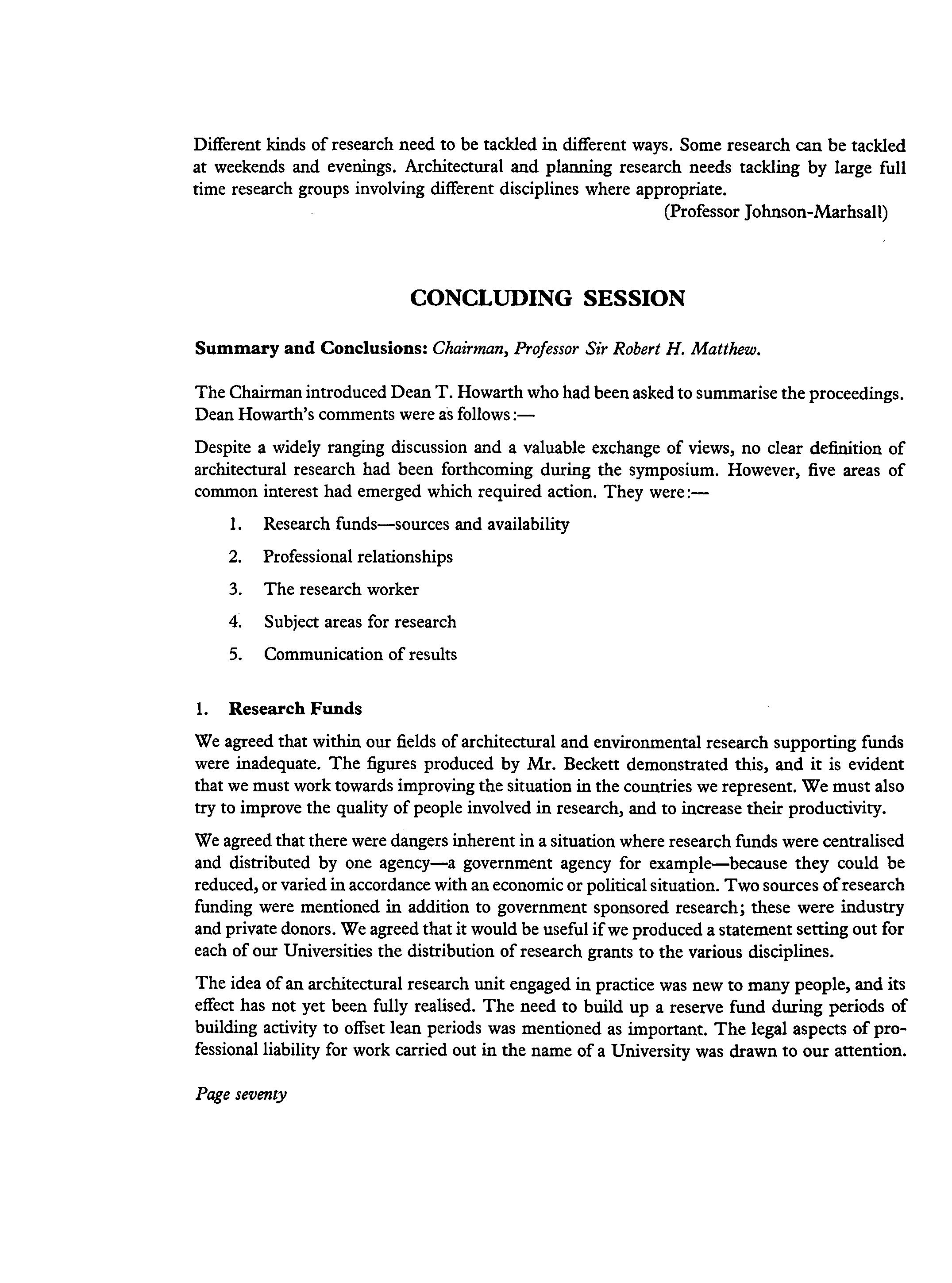
1. Research Funds
We agreed that within our fields of architectural and environmental research supporting funds were inadequate. The figures produced by Mr. Beckett demonstrated this, and it is evident that we must work towards improving the situation in the countries we represent. We must also try to improve the quality of people involved in research, and to increase their productivity. We agreed that there were dangers inherent in a situation where research funds were centralised and distributed by one agency—a government agency for example—because they could be reduced, or varied in accordance with an economic or political situation. Two sources of research funding were mentioned in addition to government sponsored research; these were industry and private donors. We agreed that it would be useful if we produced a statement setting out for each of our Universities the distribution of research grants to the various disciplines. The idea of an architectural research unit engaged in practice was new to many people, and its effect has not yet been fully realised. The need to build up a reserve fund during periods of building activity to offset lean periods was mentioned as important. The legal aspects of professional liability for work carried out in the name of a University was drawn to our attention.
Page seventy
ACTION
A comprehensive report on National and International sources of funds for architectural research should be produced together with a guide to methods of application for research grants. A list of existing research units should be prepared describing their objectives, modus operandi, and progress. Information would be welcomed on experience in sharing the expensive equipment used by individuals and research teams in other disciplines. Ways and means must be found of encouraging our professional institutes to take a more direct interest in research and help to improve the status of and facilities for research scholars and students.
2. The Profession
The problem of educating the profession not only to use the results of research but to share the responsibility for research, was discussed. Very few professional architects have taken postgraduate research degrees, and they should be encouraged to return to the University to do this. For many architects the responsibility for the building they have designed ends with its completion. Architects should be concerned more about building performance. We agreed that architects were not, and should not be, solely interested in a building as a shell, but in the total environment to which it belonged, and the social process that helped create it. The profession should have access to more objective data on which design decisions could be made.
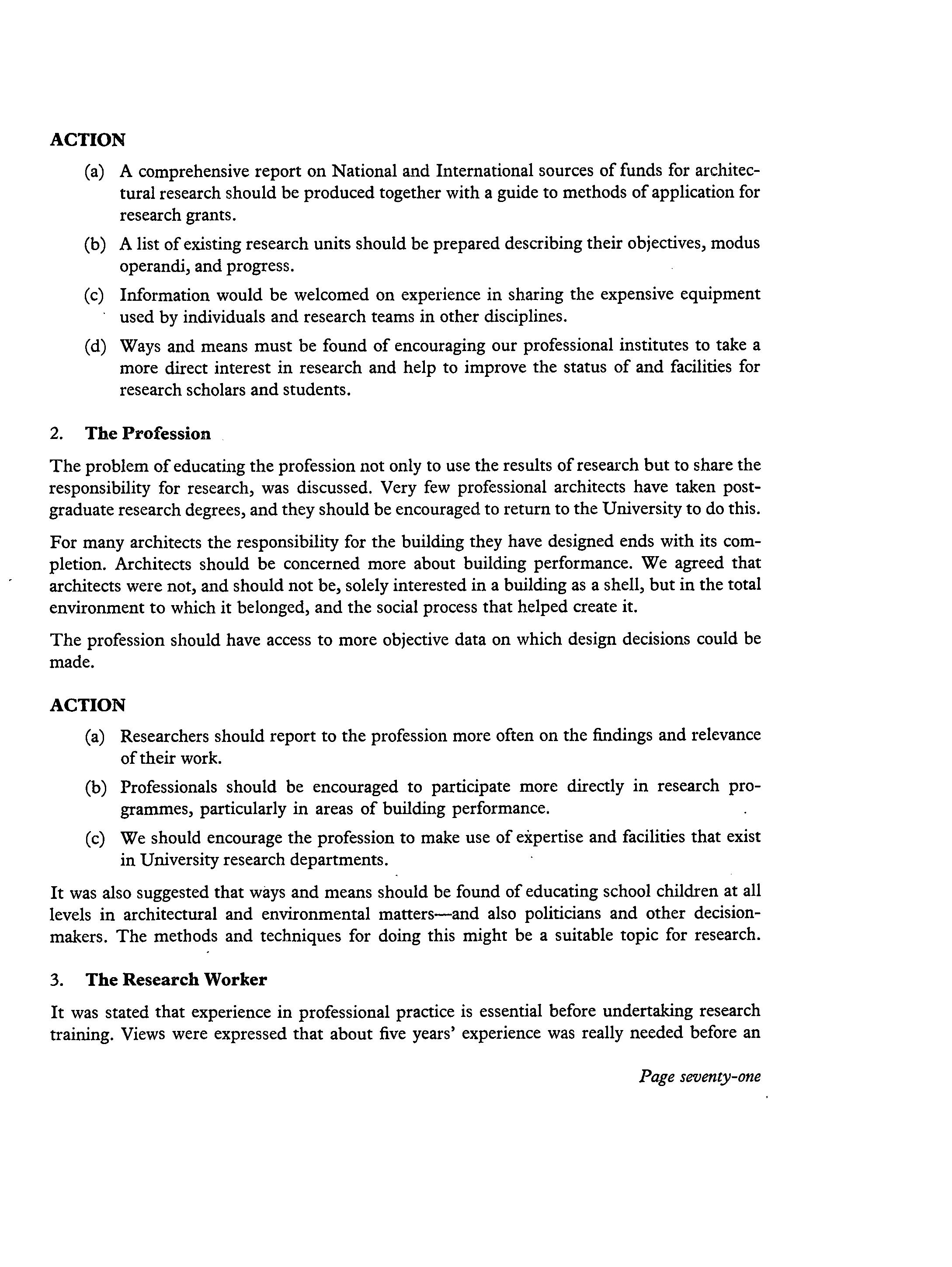
ACTION
Researchers should report to the profession more often on the findings and relevance of their work. Professionals should be encouraged to participate more directly in research programmes, particularly in areas of building performance. We should encourage the profession to make use of expertise and facilities that exist in University research departments. It was also suggested that ways and means should be found of educating school children at all levels in architectural and environmental matters—and also politicians and other decisionmakers. The methods and techniques for doing this might be a suitable topic for research.
3. The Research Worker
It was stated that experience in professional practice is essential before undertaking research training. Views were expressed that about five years' experience was really needed before an
Page seventy-one
individual could be expected to embark upon a career in research. The suitability of the architect as a research worker was also questioned. It was claimed that the research worker is required to have intelligence, compatibility and an aptitude for detailed, concentrated and systematic work —attributes that do not distinguish all architects. The problem of tenure for research staff, where continuity of effort is frequently important, was also discussed. It was claimed that the established research unit could help in this situation by providing not only a base, but a nucleus of full time staff. A difficult period was always encountered when a research project was being finished and another was not yet in sight. For the research worker this was a period when he was looking for a new contract; for the organisation it was a time of grave concern and maximum pressure. Concern was expressed at the reluctance of many countries to recognise the relevance of research experience as equivalent to practical experience in preparation for professional registration (licensing). The design process and the role of research in it was also discussed. The need to break down traditional approaches was emphasised and the need for multi-disciplinary research units was mentioned.
ACTION
A register should be established of research workers, their qualifications, and fields of interest. This should then be circulated to research institutes. The possibility of arranging the exchange of research staff on a secondment basis should be investigated. Presentation should be made to Governments and Professional Institutes on the need for establishing greater continuity in research programmes and funding.
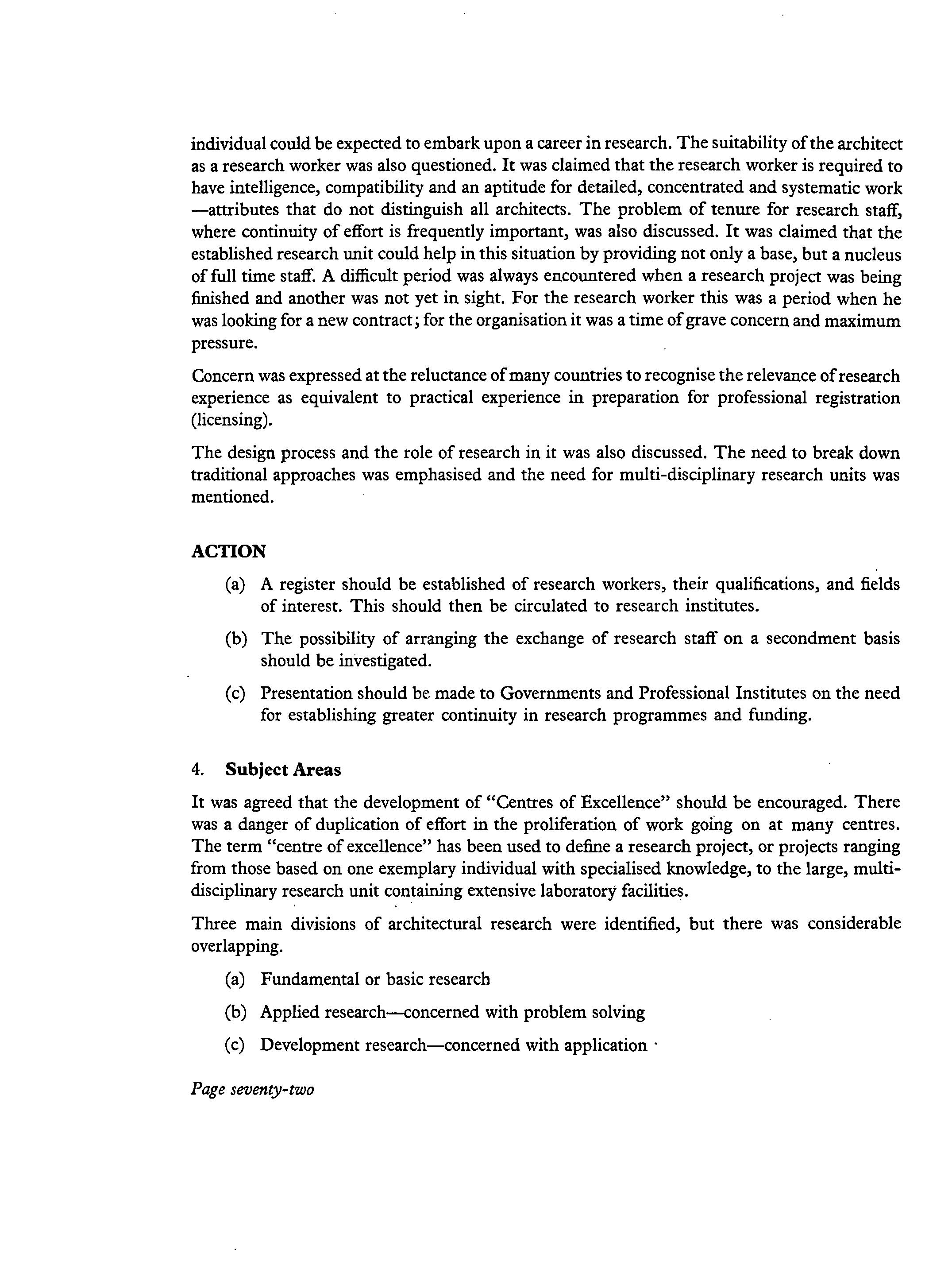
4. Subject Areas It was agreed that the development of "Centres of Excellence" should be encouraged. There was a danger of duplication of effort in the proliferation of work going on at many centres. The term "centre of excellence" has been used to define a research project, or projects ranging from those based on one exemplary individual with specialised knowledge, to the large, multidisciplinary research unit containing extensive laboratory facilities. Three main divisions of architectural research were identified, but there was considerable overlapping. Fundamental or basic research Applied research—concerned with problem solving Development research—concerned with application
Page seventy-two
The importance of the relationship between these divisions was discussed—for example, knowledge of fundamental research in a field should be considered essential before beginning a programme of applied research. The importance of inter-disciplinary research and of adequate communication between areas of research activity was stressed in this context. It was agreed that the researcher should discipline himself by tackling only the problems he is competent to deal with. There is a danger of the architect over-extending himself and getting involved in areas where others are better qualified to work than he. It was pointed out that there is invariably in these meetings a strong tendency to view world problems through western eyes and this must be corrected. The provision of shelter in developing countries was one of the world's greatest needs, and special solutions must be sought. It should be remembered that the west has not been particularly successful in providing shelter for its own poor and dispossessed peoples. A particularly valuable yet much neglected research area is that affecting government policy including, for example, planning controls and building by-laws.
ACTION
Architectural Research must be properly defined and we should attempt to clarify subject areas. An order, or priority, must be established within this classification.
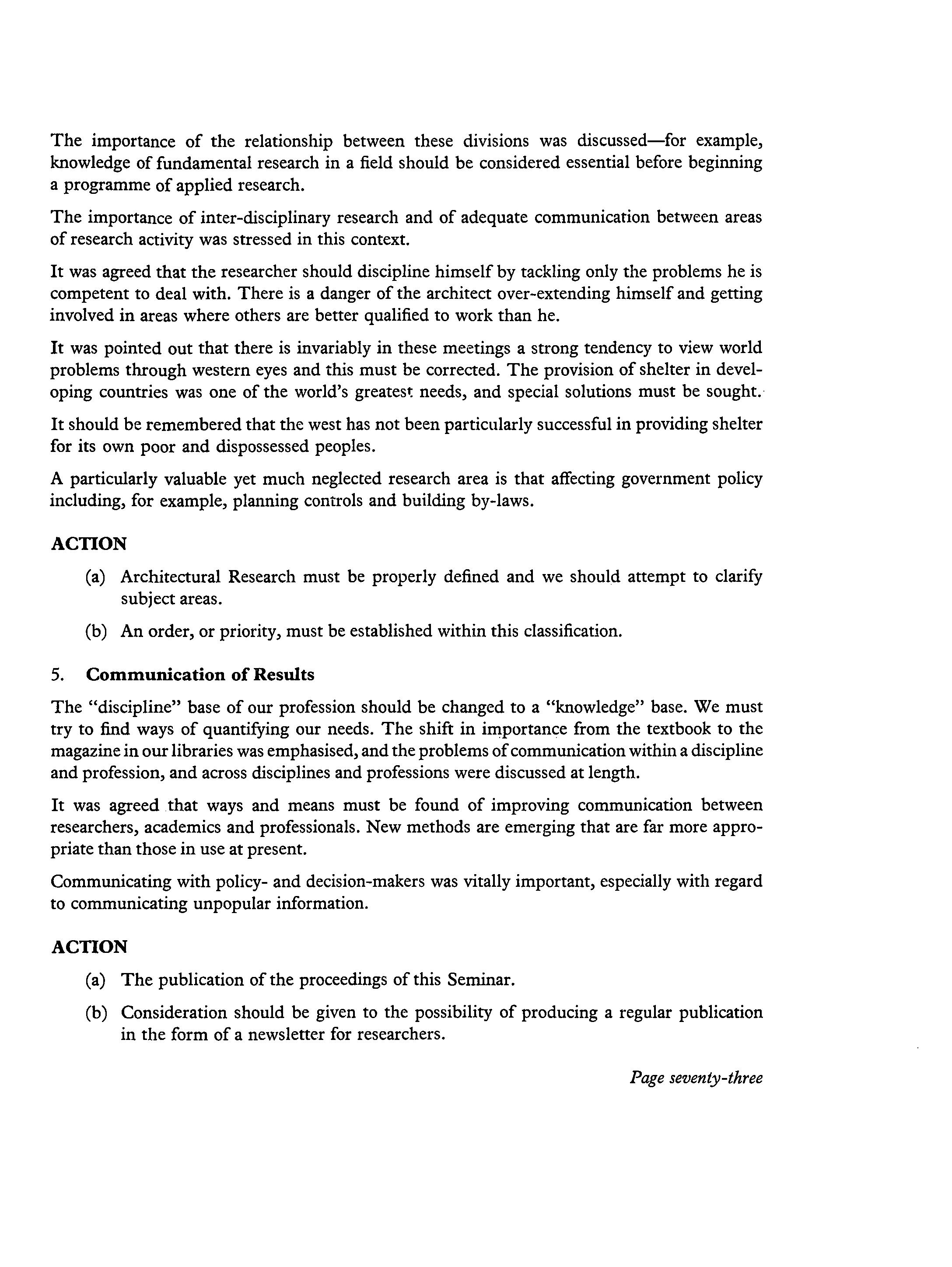
5. Communication of Results The "discipline" base of our profession should be changed to a "knowledge" base. We must try to find ways of quantifying our needs. The shift in importance from the textbook to the magazine in our libraries was emphasised, and the problems of communication within a discipline and profession, and across disciplines and professions were discussed at length. It was agreed that ways and means must be found of improving communication between researchers, academics and professionals. New methods are emerging that are far more appropriate than those in use at present. Communicating with policy- and decision-makers was vitally important, especially with regard to communicating unpopular information.
ACTION
The publication of the proceedings of this Seminar. Consideration should be given to the possibility of producing a regular publication in the form of a newsletter for researchers.
Page seventy-three
The importance of international gatherings such as this Seminar should be emphasised. We must consider how regularly we should meet, or whether some other form of communication could be as effective. Participants should bring to the attention of their respective governments and Universities the aims and objectives of this Seminar and our final report might be used for this purpose.
DISCUSSION
The Chairman thanked Dean Howarth for his summing up and asked whether there were any points participants would like to add to this. The summary was accepted and the following comments made:—
The situation in the different countries represented at the Seminar varied considerably.
We tend to discuss the two extremes, usually the United Kingdom and developing countries.
Countries like Canada and Australia have quite different problems.
(Mr. Colchester) The academic structure of research qualifications varies widely; there is no uniform pattern. What, for instance, is the present status and function of the bachelors and masters degrees in architecture? Which should be the first "professional" degree? Should the masters be a "research" degree and who will decide? (Dean Howarth) The degree structure in Schools of Architecture needs re-examining. In Edinburgh a new course is being developed which offers opportunity for identification and education of students with research potential at an earlier stage. (Professor Wilson)
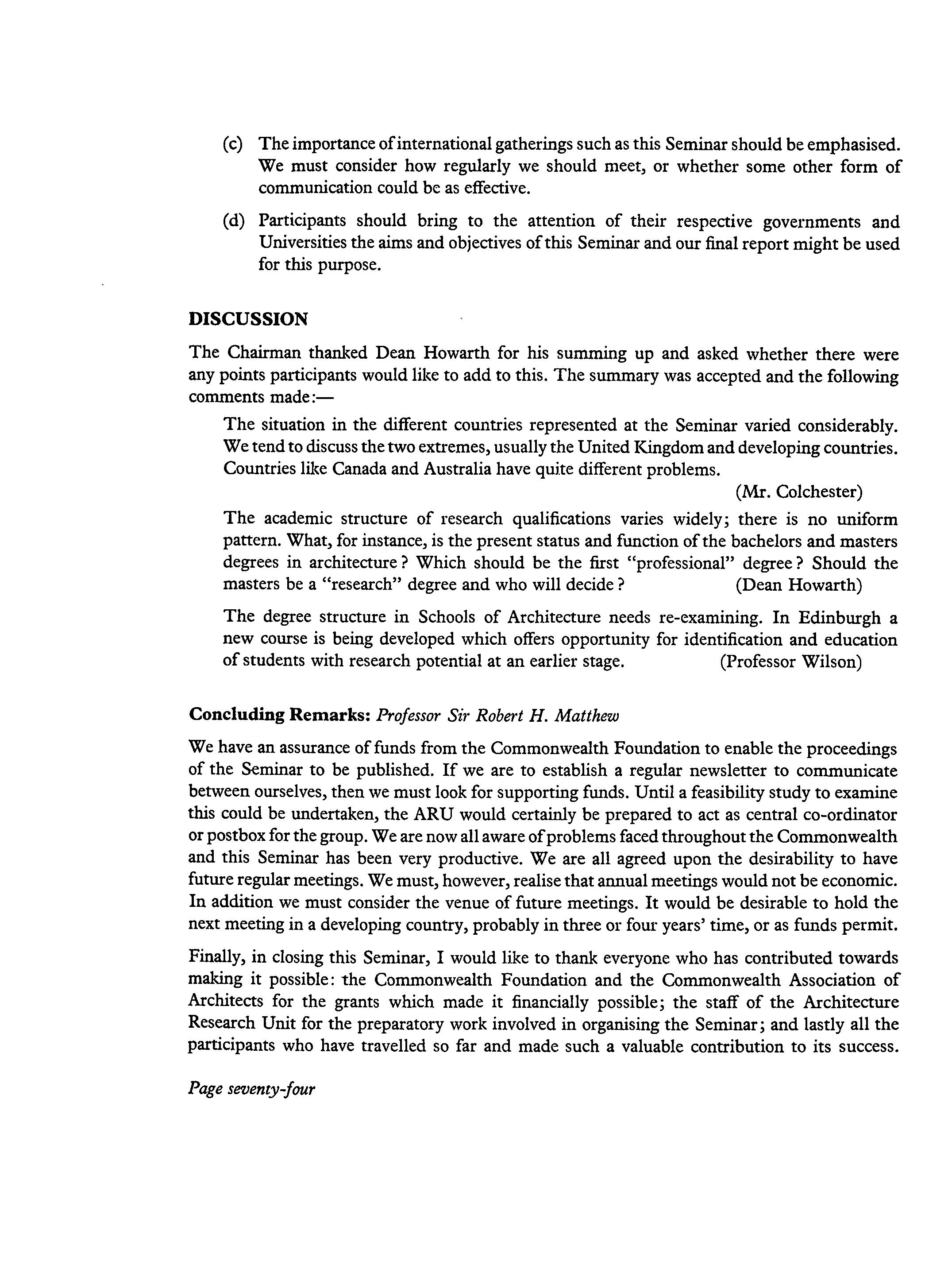
Concluding Remarks: Professor Sir Robert H. Matthew We have an assurance of funds from the Commonwealth Foundation to enable the proceedings of the Seminar to be published. If we are to establish a regular newsletter to communicate between ourselves, then we must look for supporting funds. Until a feasibility study to examine this could be undertaken, the ARU would certainly be prepared to act as central co-ordinator or postbox for the group. We are now all aware ofproblems faced throughout the Commonwealth and this Seminar has been very productive. We are all agreed upon the desirability to have future regular meetings. We must, however, realise that annual meetings would not be economic. In addition we must consider the venue of future meetings. It would be desirable to hold the next meeting in a developing country, probably in three or four years' time, or as funds permit. Finally, in closing this Seminar, I would like to thank everyone who has contributed towards making it possible: the Commonwealth Foundation and the Commonwealth Association of Architects for the grants which made it financially possible; the staff of the Architecture Research Unit for the preparatory work involved in organising the Seminar; and lastly all the participants who have travelled so far and made such a valuable contribution to its success.
Page seventy-four
PREVIOUS PAPERS IN THIS SERIES
*No. I. 'Social Work Training Needs in East Africa.' Report on Regional Seminar in Uganda, December 1967. *No. II. 'Medical Education in Papua/New Guinea (with special reference to the Teaching and Practice of Obstetrics).' Professor J. Lawson, F.R.C.0.G., November 1968. *No. III. 'Professional Managers in Indian Industry.' G. J. West, F.C.C.S., F.R.S.A., General Secretary, British Institution of Works Managers, December 1968. *No. IV. 'Mental Health Problems in the Developing World.' Report on Mental Health Workshops in Edinburgh (1968) and Kampala (1969). *No. V. 'Quality in Education.' Report on a Conference of Inspectors of Schools from the Asia/Pacific area of the Commonwealth, Singapore, 1969. *No. VI. 'Speech and Hearing Problems in South East Asia.' 1969. No. VII. 'East Coast Fever.' Final report of Edinburgh/East African Veterinary Expedition, 1969. No. VIII. 'Conference of Librarians from Commonwealth Universities in Africa.' Report of Proceedings at Lusaka, August 1969. *No. IX. 'Work Study Practice.' Report on a Regional Commonwealth Work Study Seminar, Singapore, May 1970. No. X. 'Orthopaedic Problems in the Developing World.' Report on a Commonwealth Lecture tour by Professor R. L. Huckstep, Makerere University Medical School, July-September 1970. No. XI. 'Manpower Planning in the South Pacific.' Regional Seminar in Fiji, July 1970. No. XII. 'Communications and University Teaching with particular reference to the Caribbean.' A Report from the Inter-University Research Unit, Cambridge. No. XIII. 'The Role of the Professions in a Changing World.' Report on a Conference held at the Professional Centre of Singapore, October 1971.
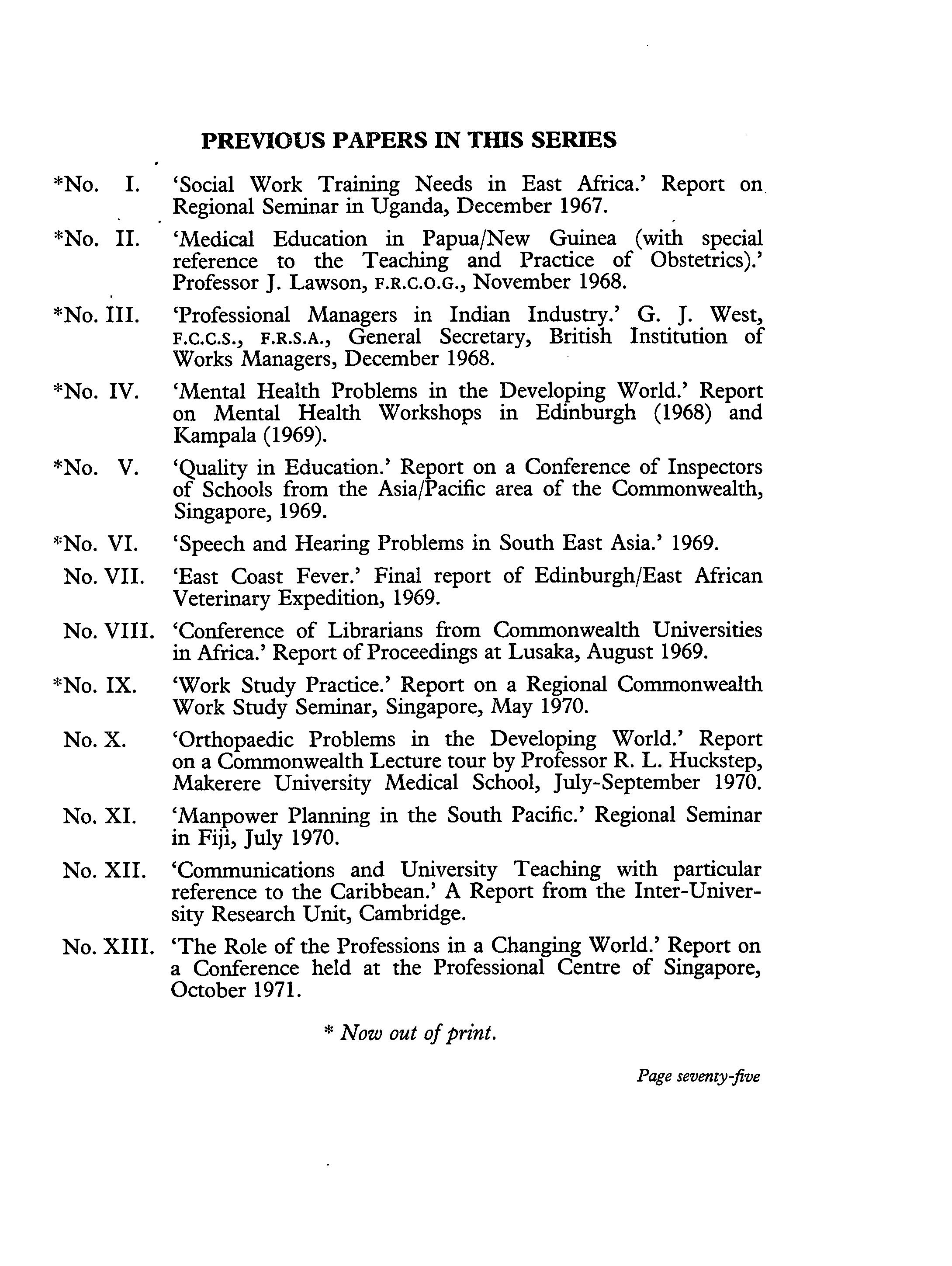
* Now out of print.
Page seventy-five
No. XIV. 'Human Ecology in the Commonwealth.' Report of a Symposium held in London in November 1971 by the Commonwealth Human Ecology Council. No. XV. 'Adult Education and National Development.' Report of a Commonwealth Planning Seminar held at the University of Manchester-in October 1972. No. XVI. 'The Commonwealth Foundation Race Relations Bursary Scheme.' Report of a Conference in London, September 1972.
First Major Publication
'Professional Organisations in the Commonwealth' (detailing upwards of 1,000 professional and learned societies and Commonwealth-wide associations). Published by Hutchinson of London, June 1970. 511 pp. Price £450.
Page seventy-six
